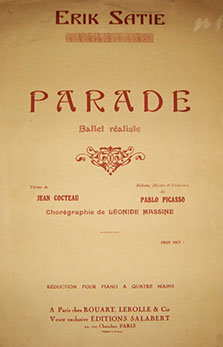Now considered a landmark of modern ballet and one of the important aesthetic salvos of modernism in general, Parade is ultimately about orientations—gesturing and pointing in numerous directions. Francis Steegmuller, writing in his biography of Cocteau, notes how
considering Cocteau’s lifelong obsession with aspects of artistic creation, it can scarcely be doubted that the chief theme of Parade—that any performance seen by an audience is as nothing compared with the invisibles that artists are up to within (whether behind the scenes, within their own heads, wherever), invisibles concerning which the painfully indifferent public lacks any interest, let alone understanding—must have had its true origin in his own realization of the contrast between what his poetic imagination was constantly suggesting to him and his dissatisfaction with most of what he had so far been able actually to produce. (161)
Parade is really about the artist behind the curtain, signaling the growing divide many artists felt at the time between their work and its impact on or relation to the world. But the ballet is also clearly about commercial, even technological spectacle and the growing demand for the “consumer’s” attention. The circus artists (a collision of the aesthetic and the commercial) are trying to attract the attention of passersby. In a doubling, the ballet orients our attention as viewers to this very process of calling attention. As ballet is a markedly embodied art, its performers call attention to the ways that bodies are deployed—in this case, bodies of difference: the Chinese acrobat, the American girl—as orienting objects. Bodies move to attract and capture attention, sometimes succeeding, sometimes failing. Such bodies, sometimes encased in rigid costumes representing concrete and steel, have become orienting objects, while also continuing to draw our attention to their difference—from each other and from their interaction with non-bodily objects, specifically the materials of industrial capitalism. Long before Latour, Parade enacts a dissolution of the subject/object binary to meditate on the interimbrication of not just self and other but the collapsing of subject into object, there and back again.

"Erik Satie Parade" by Rouart, Lerolle & Cie. Licensed under Public Domain via Wikimedia Commons.